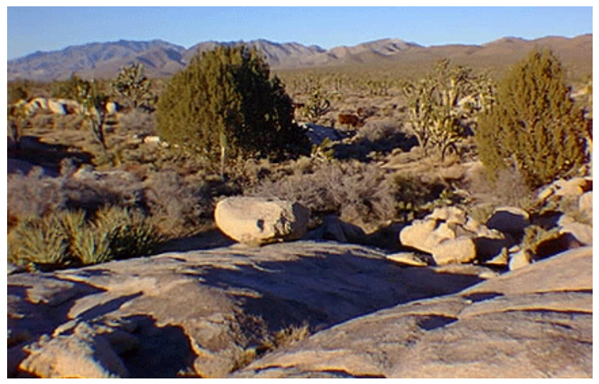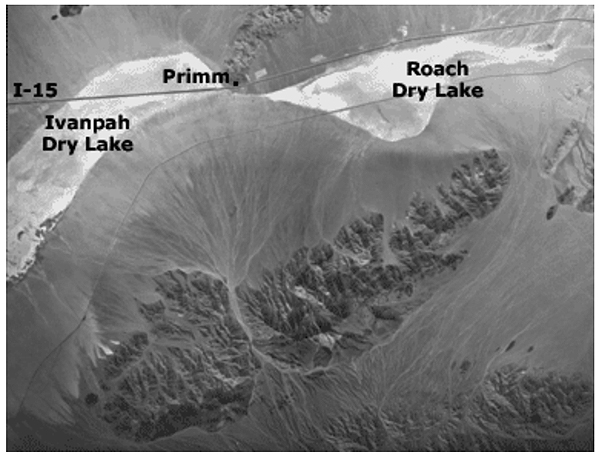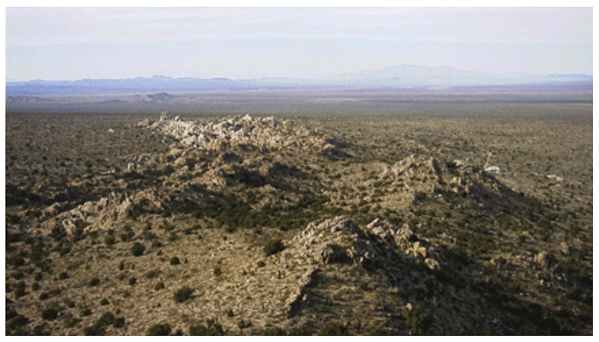Introduction
Physiography
Weather Data
Geologic History
Changing Climates
Weathering & Erosion
Carbonate Rocks
Granitic Rocks
Volcanic Rocks
Faults
Pediments
Stream Channels
Stream Terraces
The Mojave River
Playas
Sand Dunes
Human Impacts
References
Pediments and Alluvial Fans
The term, mountain front, is an imaginary borderline between a
mountainous area and a low, gently dipping plain (either a pediment or
alluvial fan). A
pediment
is a gently sloping erosion surface or
plain of low relief formed by running water in arid or semiarid region at
the base of a receding mountain front. A pediment is underlain by bedrock
that is typically covered by a thin, discontinuous veneer of soil and
alluvium derived from upland areas. Much of this alluvial material is in
transit across the surface, moving during episodic storm events or blown
by wind.

NPS photo
Granite exposures and rounded boulders shaped by spheroidal
weathering crop out on the pediment surface blanketed by a the high
Mojave desert mixed juniper and Joshua-tree forest in the vicinity
of Teutonia Mine along Cima Road.
Pediment-forming processes are much-debated, but it is clear that rocks
such as granite and coarse sandstone (and Tertiary conglomerate made up of
boulders of these rocks) form virtually all pediments in the Mojave
Desert. These rocks disintegrate grain-by-grain, rather than fracturing
and then being reduced in grain size by alluvial transport processes.
Alluvial fans
are aggrading deposits of alluvium deposited by a
stream issuing from a canyon onto a surface or valley floor. Once in the
valley, the stream is unconfined and can migrate back and forth,
depositing alluvial sediments across a broad area. View from above, an
individual deposit looks like an open fan with the apex being at the
valley mouth. Typically the fans formed by multiple canyons along a
mountain front join to form a continuous fan apron, termed a
piedmont or
bajada.

Lucy Gray Fan
Aerial view of Lucy Gray Fan, an alluvial fan that radiates from
a canyon cutting through the Lucy Gray Mountains and drains into the
Ivanpah Valley (north of the Mojave National Preserve in Nevada).
Below the mouth of the canyon the stream divides into several
channels. Active channels (void of vegetation) appear white,
whereas, darker areas on the fan are covered with vegetation and
possibly a thin veneer of soil. Channels migrate as they become
choked with sediment as flood waters seep into the ground. Coarser
rock fragments remain high on the fan, whereas finer materials
(sand, silt, and clay) will continue to migrate downslope. Only
during more intense storms will water reach and pond on the Ivanpah
playa.
Large areas within the Mojave Desert are pediment surfaces. These
pediments reflect both the antiquity of some mountain structures in the
region and the persistent arid climatic conditions in the region. Perhaps
the most notable pediment in the region is Cima Dome,
a very broad,
shield-shaped upland area within the Mojave National Preserve (below).
This great, gently-sloped upland area represent a region where
desert-style weathering and erosion has stripped away most of the relief
to the point that the erosion keeps pace with surface weathering and that
surface gradient is gentle enough to prevent gully-style downcutting.
Isolated rocky hills or knobs that rise abruptly from an erosional surface
in desert regions are called inselbergs.

NPS photo
The broad, gradual arch of Cima Dome is a mature pediment
surface broken by relatively small "rock islands" (inselbergs).
Teutonia Peak is the small peak to the left of the high point on
Cima Dome. This view is from along Cima Road, about five miles (8
kilometers) south of Interstate 15. The flat plain in the foreground
is also a pediment with a thin veneer of alluvium.

NPS photo
This view from the top of
Teutonia Peak
faces north over the
northern flank of
Cima Dome. Rock
knobs of spheroidal-weathering
granite bedrock rise above the pediment surface that consists of
barren weathered granite bedrock covered with a thin intermittent
veneer of sediment and soil. This expansive pediment surface
probably extends to the flank of the mountains in the distance.
(This is looking back toward the foreground area shown in the image
above.) Rock underlying Teutonia Peak is Jurassic grainite, which
generally does not form pediments; adjacent pediment-forming rock of
Cima Dome is Cretaceous in age.

NPS photo
Pediment domes and islenbergs define the landscape in the
central portion of the Mojave National Preserve. This view faces
north from an alluvial fan draining the Providence Mountains towards
the pediment dome upland region of the Marl Mountains. Kelso Wash is
the axial trunk stream in the middle of the valley. In the
foreground, a relatively stable alluvial fan surface consists of
desert pavement broken by braided stream channels and a patchwork of
vegetation (mostly white bursage [gray] and creosote bush [green]).
Total surface relief in this lower portion of the fan is in the
range of one meter.
The development of pediments and alluvial fans is progressive with the
uplift of mountains and subsidence of adjacent basins. Pediments reflect a
relative "static equilibrium" between erosion of materials from upland
areas and deposition within an adjacent basin. The slope of the landscape
is gentle enough that weathering and transport of sediments from upland
areas and the pediment that no significant stream incision occurs. In many
areas throughout the Mojave region it is nearly impossible to see where a
pediment ends and alluvial fans begin, however, geophysical data and
water-well drilling shows that in many places sediment filled basins do
occur adjacent to pediment areas.
The impact of climate change on alluvial fans has been the focus of
much research. Studies show that a period of elevated alluvial fan
deposition occurred between the time of the Last Glacial Maximum (about
15,000 years ago) and the beginning of arid conditions in the early
Holocene (about 9,400 years ago). McDonald et al, (2003) suggest
that the climatic transition from seasonable wet conditions to arid
conditions, punctuated by extreme storm event (possibly associated with
tropical cyclones) may be responsible for this change. Today, heavy
rainfalls rarely provide enough precipitation to allow enough surface
runoff to occur on highly porous soils and colluvium. Only during major
stream event will water discharge in volume and intensity to move material
from mountain source areas to lower fan areas. In addition to extreme
storm events,the buildup of alluvial fan deposits at this
Pleistocene/Holocene time transition may be linked with the transition
from widespread plant cover to the more barren character of the modern
Mojave landscape. Die-back of plants would decrease rooting, making more
mountain-side material available for erosion and transport to alluvial
fans.
Next > Stream Channel Development